

How to Add Projects in LinkedIn: A Step-by-Step Guide
Did you know that you can add projects to your LinkedIn profile? Yes, you can add a different section to your LinkedIn page that talks about your professional profile in a new way: via the projects you worked on.
And you definitely should. Let’s find out why and how you can use this powerful feature to boost your professional profile and make it more attractive to potential clients and hiring managers.
What’s the value of adding projects to your profile?
Projects are a great way of showcasing what you can do and to provide some real data behind your work experience. People are always saying that your LinkedIn page should talk about your results, not your jobs, and projects are the evidence you can add to show the impact you made through your work.
You can add in specific information relating to a particular project. Show off your best work in a way that definitely doesn’t feel like you are boasting! LinkedIn should be more than an online resume. Making use of all the available sections helps present you professionally in a rounded way, with more detail than you can include in a cover letter or CV.
Whether you are open to work or simply building your personal brand as a leader in your field, having your projects on your public profile is a way to increase your network because it makes it easier for people to find you – more on adding keywords in project descriptions later.
What sort of projects can you add?
Projects in LinkedIn are attached to a role, so as long as the role is included in your profile, you can add any kind of project. From initiatives you led as part of your volunteer experience to linking to your digital portfolio as a graphic designer, you can add pretty much anything. Just make sure they are related to your work history in some way!
Each project can include a URL, so if you have a website of your own, projects are also a way to drive traffic back to your site. Or link out to your clients as a way of showing the kinds of organizations you work with.
It doesn’t have to take a lot of time to add projects to your profile. Here’s how to do it.
How to add projects to LinkedIn
First, go to your profile.
From your profile, click the link to edit it.
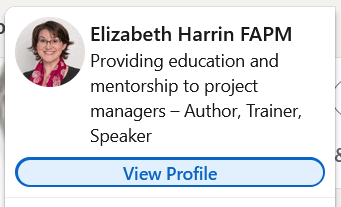
Add a Projects section
If you don’t currently have projects on your profile, you will need to add a section. Click Add section.
Then find Projects – it’s under the Accomplishments menu.
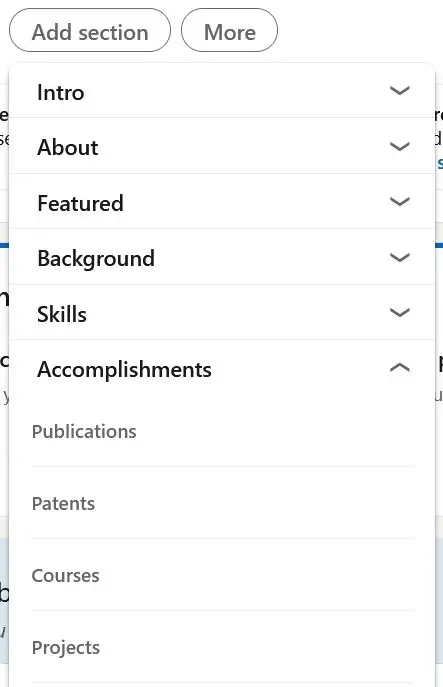
Add your first project
Next, you’ll see the popup that prompts you to add a LinkedIn project.
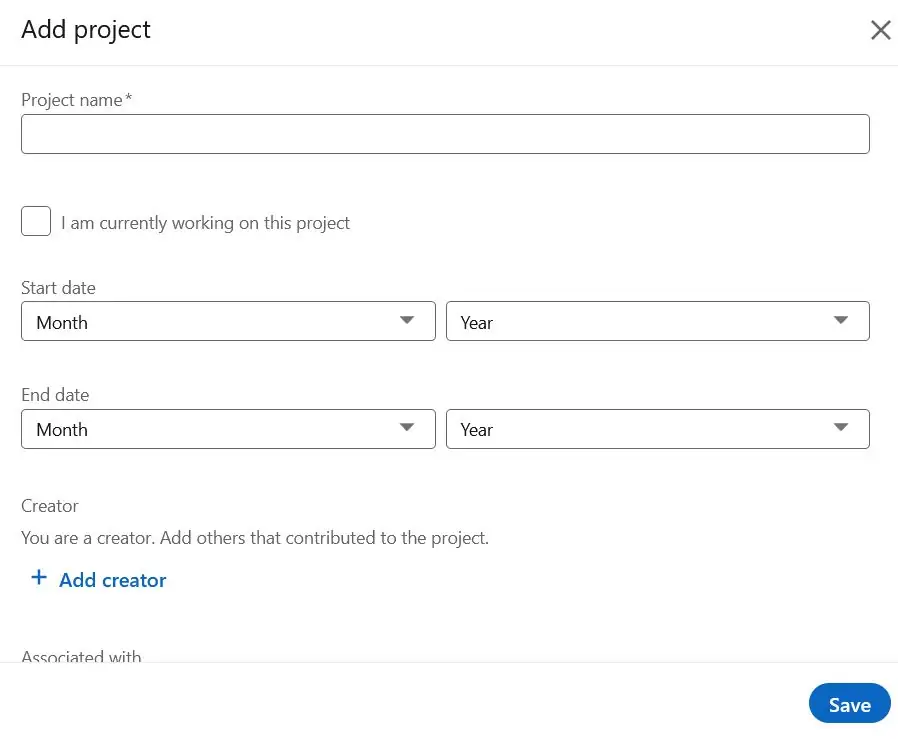
Type in the details for the project. You’ll need to include:
- Project name.
- Start date and end date (it’s OK to just have years).
- Any other colleagues who worked on the project with you.
- The role it was associated with – select this from the drop-down list of your roles that are already on LinkedIn. If the project relates to a new role, add that first.
- Project URL if it is a publicly available project or something you can link to.
- Description. You’ve got 2,000 characters to talk about what you did and what the project was all about.
Adding colleagues
If relevant team members that worked with you are already your LinkedIn connections, they will show up and you can select them from a drop-down list.
If you are not connected with them, you can add their names, but I would recommend you don’t. There’s no need to tag people who aren’t connected with you on LinkedIn. No one is going to assume you did all the work yourself just because someone isn’t listed.
You might even find that colleagues reach out to you and ask to be added!
You don’t have to limit it to colleagues. If you worked with clients, link to your clients’ profile, or key suppliers, or any of the additional, wider stakeholder community to whom you are connected.
Writing project descriptions
LinkedIn is often used as a search engine for recruiters, so you can use project-related keywords in your descriptions as a way to signal to potential employers that you have experience in certain areas.
Use your job description for your current role as inspiration for the words to use, or look for keywords in the project management job descriptions of the roles you want to apply for. This will help your profile show up in the search results.
Start with an attractive project name that is both descriptive and interesting. You have loads of characters, so add in as much information as possible, but it needs to be relevant information. Think of projects like case studies for what you are capable of, so talk about all the elements of the work, from your interpersonal styles and navigating different work styles to your technical skills as a project manager, like risk management .
Do not write the description in the third person. You can talk about what you did and how you managed the work. Ultimately, this is your personal choice, but I think it sounds a bit odd on your professional profile page to be talking about yourself in the third person, especially when it comes to describing the things you actually did.
If you prefer to stick with third person, that’s up to you, but make sure all your projects are written that way so they are consistent.
I’ve written before about how to list project management skills on your resume , so take a look at that if you need some help dropping the right kinds of phrases into your online profile.
The LinkedIn Accelerator is your step-by-step guide to creating a profile to impress.
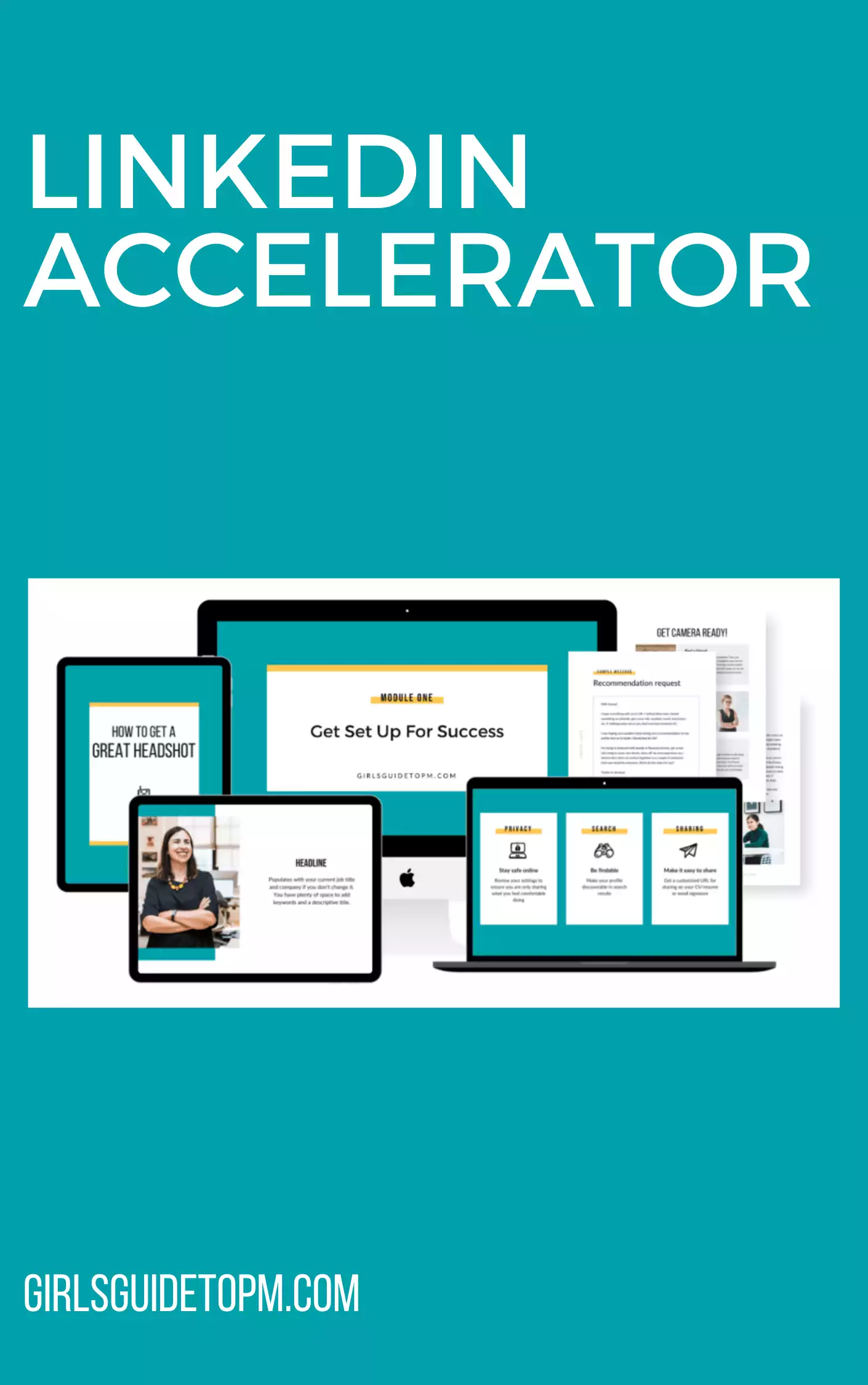
Example of a project description
Here’s what I wrote for one of my projects.
I managed a core central project team of 6 people, who were joined by business specialists and secondees as required throughout the lifecycle of the project.
The overall budget for the 4-year program was about £10m. I took over budgetary responsibilities in 2009. In 2010 the amount under my direct control was £2.6m (capital).
This program included major capital purchases of IT systems from two vendors. I was responsible for the project contract management; this included attending monthly supplier meetings. I was involved in the annual renegotiation of supplier maintenance contracts.
I copied and pasted that from my APM Fellowship application form, which handily had all the dates of my project work on as well! (At least up until the point I applied… after that, my exact project dates are a bit hazy as my records aren’t that brilliant.)
You can write a lot more, and if you are a job seeker, it’s a good idea to be as descriptive as possible to show off your own skills as well as the work you did.
Remember, people will be judging your communication skills , so proofread your work!
Save your project
Click Save. You’re one step closer to having a complete profile!
Add another project if you want to list more accomplishments. Keep going until you feel like you’ve done enough.
View your LinkedIn project
Now find your project on your profile. It will be in the accomplishments section.
Expand the section with the drop-down arrow and you’ll see all the text. If it doesn’t look like you want, or if you remembered some extra details worth adding, click the pencil icon to edit it.
The downside of how it appears on your profile is that it is not displayed alongside your role in the experience section. Despite choosing what role relates to the project, they don’t appear to be connected in any way.
I think that’s a pity, as hiring managers (or just normal LinkedIn members) will have to scroll way down to the bottom of your profile to see the projects, and then guess which ones relate to which jobs, using the dates as a guide.
Because of this, you might want to add the company name into the project description so it’s really clear which project relates to which role.
LinkedIn may well change this in the future – all the social media apps mix up how information is displayed and entered as they constantly evolve.
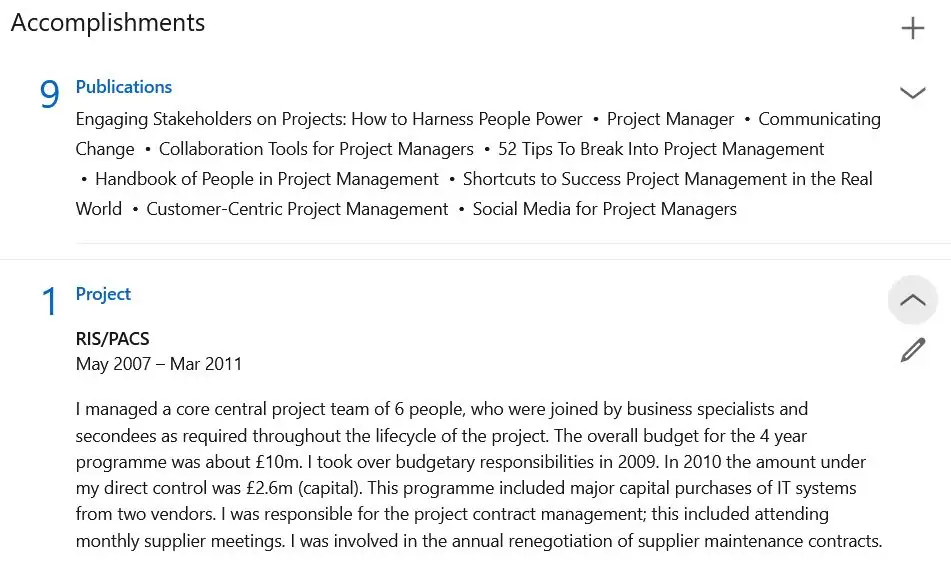
Your next steps
Ready to add projects to your LinkedIn profile? As you can see, it’s really easy, so here’s what to do now.
- Login to your LinkedIn account
- Follow the steps above to add some awesome projects that relate to your work experience
- While you’re in there, make sure the other parts are filled out, like the education section and your current position
- Try to keep your LinkedIn profile up to date and stay an active user of the site so next time it’s not such a mammoth job to add all your past experiences and projects!
- Read how to include projects on your resume or CV
- Read how to showcase your project management skills on LinkedIn

Project manager, author, mentor
Elizabeth Harrin is a Fellow of the Association for Project Management in the UK. She holds degrees from the University of York and Roehampton University, and several project management certifications including APM PMQ. She first took her PRINCE2 Practitioner exam in 2004 and has worked extensively in project delivery for over 20 years. Elizabeth is also the founder of the Project Management Rebels community, a mentoring group for professionals. She's written several books for project managers including Managing Multiple Projects .
Capstone Projects
The Capstone is a culminating academic project experience that is completed within the confines of a semester-length course. Several Master of Liberal Arts (ALM) fields either require a capstone or offer the option to pursue one. In addition to the information below, review Guide to the ALM Capstone Project website.
Types of Capstones
We offer two forms of capstone: Capstone Course (faculty directed) and Capstone Independent Project (student directed).
Capstone Course–Faculty Directed
For the ALM fields of anthropology, biotechnology, creative writing and literature, computer science, cybersecurity, data science, English, government, history, international relations, math for teaching, psychology, religion, and systems engineering capstones are courses designed by faculty members who bring together, in a structured syllabus, all the key learning outcomes of the field of study.
Our cybersecurity, data science, and computer science capstones are team-based projects that have a real-world industry partner as the client for your research.
While our creative writing capstone allows for ample room to work on individual artistic projects, but with the added benefit of weekly engagement with peers and the instructor–a supportive writer’s community.
Every effort is made to offer the same precapstone/capstone topics each year (e.g., human development, policy analysis, and social justice); however, topics are subject to change annually.
Good academic standing. You must be good academic standing to register for the capstone. If not, you’ll need to complete additional courses to bring your GPA up to the 3.0 minimum prior to registration. For detailed course description information, including specific registration requirements, such as credit minimums and academic standing requirements, use the Degree Course Search .
Tip: Register on the first day of early degree-candidate registration to obtain a seat in these limited-enrollment courses.
Precapstones
The ALM fields of anthropology, biotechnology, computer science, creative writing and literature, cybersecurity, data science, English, government, history, international relations, psychology, religion and systems engineering have a required precapstone course that must be completed with a grade of B- or higher.
Mandatory Sequencing of Precapstones/Capstones. You enroll in the precapstone and capstone courses in back-to-back semesters (fall/spring), with the same instructor, and in your final academic year.
Due to heavy workload demands, all your other degree requirements must be fulfilled prior to capstone registration. The capstone must be taken alone as your one-and-only remaining degree requirement. You cannot register in any other courses along with the capstone.
It is critical that you draw upon your entire ALM training to produce a project worthy of a Harvard degree by committing to full-time study in the capstone.
Engaging in Scholarly Conversation . For precapstones in anthropology, English, government, history, international relations, psychology or religion, you need to have completed Engaging in Scholarly Conversation prior to precapstone registration. If you were admitted after 9/1/2023, Engaging in Scholarly Conversation (A and B) is required; if admitted before 9/1/2023, this series is encouraged.
Attempts . You have a maximum of two attempts at the precapstone course to earn the required grade of B- or higher. If after two attempts, you have not fulfilled the requirement (a WD grade is considered an attempt), your degree candidacy will expire. If by not passing the precapstone you fall into poor academic standing, you will need to take additional degree-applicable courses to return to good standing before enrolling in the precapstone for your second and final time.
The second attempt policy is only available if your five-year, degree-completion deadline allows for more time. If you attempt to complete the precapstone in your final year and don’t pass (including a WD grade), your candidacy will automatically expire.
For detailed course description information, visit the Degree Course Search .
Capstone Independent Project–Student Directed
For global development practice, digital media design, journalism, museum studies, and sustainability, capstones are client-based or independent research projects focused on a current issue or problem that has become compelling for you during your course of study. The project represents your academic passion and professional interest. You complete the research individually (journalism) or in a classroom setting with fellow candidates (all other fields).
Journalism candidates should scroll down to Journalism Capstone. The following applies to:
- Global Development Practice
- Digital media design
- Museum studies
- Sustainability
Registration in the capstone for the above fields has the following prerequisites: (1) your specific research project must be approved several months in advance (prior to enrolling in the precapstone tutorial), (2) you must successfully complete the precapstone tutorial, and (3) the capstone must be your final, one-and-only remaining degree requirement. You cannot register for any other courses along with the capstone.
There are two major steps to obtain project approval.
Step one: obtain advice right away. Once admitted to the program, meet with your research advisor early and often about your initial capstone research interests. He or she can provide support as well as course selection advice as you develop preliminary ideas. Please note that while every effort is made to support your capstone interest, guidance is not available for all possible projects. Therefore, revision or a change of capstone topic may be necessary.
- For museum studies your capstone will have a main focus on (1) business of museums, (2) collections care, (3) exhibition design, (4) museum education, or (5) technology. Whatever focus you choose, you must have at least two courses completed in that area before enrolling in the precapstone tutorial. If not, your enrollment will not be approved.
- Due to the highly technical nature of their projects, digital media students must meet with their research advisor, Dr. Hongming Wang, to discuss their capstone topics according to the following schedule. Between January 2 and February 15 for summer precapstone and between May 1 and July for the fall precapstone. Appointments can be scheduled through the Degree Candidate Portal.
- Step two: register for the noncredit tutorial. The semester before capstone registration (no earlier), you are required to (1) enroll in the noncredit Precapstone tutorial, (2) visit the Guide to the ALM Capstone Project website to read through the tutorial guidelines, and (3) submit your prework by the required deadline (see below in bold).
Prework demonstrates that you have done enough prior reading and research on your topic to begin the capstone proposal process. Registration in the tutorial is limited to degree candidates who submit quality prework. If your prework is not approved, you will need to spend time revising in order to re-submit for the next offering of the tutorial, if your five-year, degree-completion deadline allows.
Once registered in the noncredit tutorial, you will receive guidance and mentoring while you iterate on your individual capstone proposal until the document reaches a satisfactory quality. The tutorial is not a course in the traditional sense. You work independently on your proposal with your research advisor by submitting multiple proposal drafts and scheduling individual appointments (ordinarily, during the hours of 9-5). You need to make self-directed progress on the proposal without special prompting from the research advisor. While the tutorial is noncredit, your due diligence throughout the semester is required.
If you do not have a proposal that is close to being approved by the semester’s withdrawal deadline, you’ll need to withdraw from the tutorial, delay capstone registration, and re-take the capstone proposal tutorial again in a future semester, if your five-year, degree-completion deadline allows.
- For the fall capstone, you complete the proposal tutorial during the prior summer term: Register for the Summer Precapstone tutorial March 1. Submit the first draft of the preproposal between March 1 and May 15 . Actively participate in the tutorial during the summer and end the term with an approved proposal. Register and complete capstone in fall.
- For the spring capstone, you complete the proposal tutorial during the prior fall term: Register for the Fall Precapstone tutorial when registration opens in mid-July. Submit the first draft of the preproposal between July 18 and August 1 . Actively participate in the tutorial during the fall and end the term with an approved proposal. Register and complete the capstone in spring.
- For the summer capstone, you complete the proposal tutorial during the prior spring: Register for the spring Precapstone tutorial when registration open in early November. Submit the first draft of the preproposal between November 7 and January 2 . Actively participate in the Capstone Proposal Tutorial during the spring and end the term with an approved proposal. Register and complete capstone in summer. This sequence (spring tutorial, summer capstone) is required for international students who need a student visa.
Please note that not all fields offer a capstone each term. Refer to your field’s Degree Course Search for the schedule.
Human Subjects
If your capstone will involve the use of human subjects (e.g., subject interviews, surveys, observations), review the Human Subjects section on the Guide to the ALM Capstone Project website to learn Harvard University’s Institutional Review Board (IRB) approval process.
Journalism Capstone
Over the course of the capstone semester for JOUR E-599 , you’ll conduct an in-depth investigation of a single topic and emerge with a portfolio of new work suitable for publishing, posting, or broadcasting. The portfolio requires you to produce several (at least three) related stories on one topic written specifically for the capstone course. (No prior work can be used.) The stories are completed over the course of one semester.
You can register for the capstone once you complete 36 credits, and you work independently to complete the project within a semester time frame. The capstone can be, and often is, completed at a distance.
To begin the capstone approval process, you schedule an appointment with your research advisor, June Erlick, ( [email protected]) , to discuss your capstone ideas.
While every effort is made to support your capstone interest, guidance is not available for all possible projects. Therefore, revisions or a change of capstone topic may be necessary before it is approved. As in all traditional journalism, projects must take a fair and balanced view by bringing in differing points of view. Projects should not be one-sided or take an advocacy stance.
Once a topic is approved, you submit the first draft of your capstone proposal. (Visit the Guide to the ALM Capstone Project website to read the specific guidelines for Crafting the Capstone Proposal). Ms. Erlick supports you through the fine tuning of the proposal and works with the Journalism program office to identify a capstone director. Once approved, capstone topics cannot be changed. In the unlikely event that you cannot continue with the project as approved, you must request and receive written permission to pursue a new topic from Ms. Erlick.
A capstone director is a journalism instructor or professional in the field who has expertise relevant to your capstone topic. The final decision about who will serve as director is made by the Journalism program office; however, you are welcome to request a particular instructor. However, we ask that you not contact an instructor directly prior to capstone approval.
You are expected to work independently on your project with support and direction from the director. The capstone director will meet with you several times over the semester to answer questions, discuss your progress, read drafts, and offer feedback. The director also grades the final project.
Journalism Timeline
- Fall capstone: Meet to discuss capstone ideas by May 1. Submit first draft of capstone proposal by June 1.
- Spring capstone: Meet to discuss capstone ideas by September 1. Submit first draft of capstone proposal by October 1.
- Summer capstone: Meet to discuss capstone ideas by February 1. Submit first draft of capstone proposal by March 1
Final Capstone Grade
You need to earn a grade of B- or higher to earn degree credit for the capstone. If you earn a grade below a B– (including a WD), you will need to petition the Administrative Board for permission to enroll in the capstone for one final time. The Board only reviews cases in which extenuating circumstances prevented the successful completion of the capstone.
Moreover, the petition process is only available if your five-year, degree-completion deadline allows for more time. Your candidacy will automatically expire if you do not successfully complete the capstone requirement by your required deadline.
If approved for a second attempt, you may be required to repeat the precapstone course or the non-credit precapstone tutorial. Please note that you cannot choose a different precapstone/capstone sequence to gain additional (more than two) attempts at fulfilling the capstone requirement for your degree.
If by not passing the capstone you fall into poor academic standing, you’ll need to take additional degree-applicable courses to return to good standing before enrolling in the capstone for your second and final time. This is only an option if your five-year, degree-completion deadline allows for more time to take additional courses.
Harvard Division of Continuing Education
The Division of Continuing Education (DCE) at Harvard University is dedicated to bringing rigorous academics and innovative teaching capabilities to those seeking to improve their lives through education. We make Harvard education accessible to lifelong learners from high school to retirement.


10 Unique Data Science Capstone Project Ideas
A capstone project is a culminating assignment that allows students to demonstrate the skills and knowledge they’ve acquired throughout their degree program. For data science students, it’s a chance to tackle a substantial real-world data problem.
If you’re short on time, here’s a quick answer to your question: Some great data science capstone ideas include analyzing health trends, building a predictive movie recommendation system, optimizing traffic patterns, forecasting cryptocurrency prices, and more .
In this comprehensive guide, we will explore 10 unique capstone project ideas for data science students. We’ll overview potential data sources, analysis methods, and practical applications for each idea.
Whether you want to work with social media datasets, geospatial data, or anything in between, you’re sure to find an interesting capstone topic.
Project Idea #1: Analyzing Health Trends
When it comes to data science capstone projects, analyzing health trends is an intriguing idea that can have a significant impact on public health. By leveraging data from various sources, data scientists can uncover valuable insights that can help improve healthcare outcomes and inform policy decisions.
Data Sources
There are several data sources that can be used to analyze health trends. One of the most common sources is electronic health records (EHRs), which contain a wealth of information about patient demographics, medical history, and treatment outcomes.
Other sources include health surveys, wearable devices, social media, and even environmental data.
Analysis Approaches
When analyzing health trends, data scientists can employ a variety of analysis approaches. Descriptive analysis can provide a snapshot of current health trends, such as the prevalence of certain diseases or the distribution of risk factors.
Predictive analysis can be used to forecast future health outcomes, such as predicting disease outbreaks or identifying individuals at high risk for certain conditions. Machine learning algorithms can be trained to identify patterns and make accurate predictions based on large datasets.
Applications
The applications of analyzing health trends are vast and far-reaching. By understanding patterns and trends in health data, policymakers can make informed decisions about resource allocation and public health initiatives.
Healthcare providers can use these insights to develop personalized treatment plans and interventions. Researchers can uncover new insights into disease progression and identify potential targets for intervention.
Ultimately, analyzing health trends has the potential to improve overall population health and reduce healthcare costs.
Project Idea #2: Movie Recommendation System
When developing a movie recommendation system, there are several data sources that can be used to gather information about movies and user preferences. One popular data source is the MovieLens dataset, which contains a large collection of movie ratings provided by users.
Another source is IMDb, a trusted website that provides comprehensive information about movies, including user ratings and reviews. Additionally, streaming platforms like Netflix and Amazon Prime also provide access to user ratings and viewing history, which can be valuable for building an accurate recommendation system.
There are several analysis approaches that can be employed to build a movie recommendation system. One common approach is collaborative filtering, which uses user ratings and preferences to identify patterns and make recommendations based on similar users’ preferences.
Another approach is content-based filtering, which analyzes the characteristics of movies (such as genre, director, and actors) to recommend similar movies to users. Hybrid approaches that combine both collaborative and content-based filtering techniques are also popular, as they can provide more accurate and diverse recommendations.
A movie recommendation system has numerous applications in the entertainment industry. One application is to enhance the user experience on streaming platforms by providing personalized movie recommendations based on individual preferences.
This can help users discover new movies they might enjoy and improve overall satisfaction with the platform. Additionally, movie recommendation systems can be used by movie production companies to analyze user preferences and trends, aiding in the decision-making process for creating new movies.
Finally, movie recommendation systems can also be utilized by movie critics and reviewers to identify movies that are likely to be well-received by audiences.
For more information on movie recommendation systems, you can visit https://www.kaggle.com/rounakbanik/movie-recommender-systems or https://www.researchgate.net/publication/221364567_A_new_movie_recommendation_system_for_large-scale_data .
Project Idea #3: Optimizing Traffic Patterns
When it comes to optimizing traffic patterns, there are several data sources that can be utilized. One of the most prominent sources is real-time traffic data collected from various sources such as GPS devices, traffic cameras, and mobile applications.
This data provides valuable insights into the current traffic conditions, including congestion, accidents, and road closures. Additionally, historical traffic data can also be used to identify recurring patterns and trends in traffic flow.
Other data sources that can be used include weather data, which can help in understanding how weather conditions impact traffic patterns, and social media data, which can provide information about events or incidents that may affect traffic.
Optimizing traffic patterns requires the use of advanced data analysis techniques. One approach is to use machine learning algorithms to predict traffic patterns based on historical and real-time data.
These algorithms can analyze various factors such as time of day, day of the week, weather conditions, and events to predict traffic congestion and suggest alternative routes.
Another approach is to use network analysis to identify bottlenecks and areas of congestion in the road network. By analyzing the flow of traffic and identifying areas where traffic slows down or comes to a halt, transportation authorities can make informed decisions on how to optimize traffic flow.
The optimization of traffic patterns has numerous applications and benefits. One of the main benefits is the reduction of traffic congestion, which can lead to significant time and fuel savings for commuters.
By optimizing traffic patterns, transportation authorities can also improve road safety by reducing the likelihood of accidents caused by congestion.
Additionally, optimizing traffic patterns can have positive environmental impacts by reducing greenhouse gas emissions. By minimizing the time spent idling in traffic, vehicles can operate more efficiently and emit fewer pollutants.
Furthermore, optimizing traffic patterns can have economic benefits by improving the flow of goods and services. Efficient traffic patterns can reduce delivery times and increase productivity for businesses.
Project Idea #4: Forecasting Cryptocurrency Prices
With the growing popularity of cryptocurrencies like Bitcoin and Ethereum, forecasting their prices has become an exciting and challenging task for data scientists. This project idea involves using historical data to predict future price movements and trends in the cryptocurrency market.
When working on this project, data scientists can gather cryptocurrency price data from various sources such as cryptocurrency exchanges, financial websites, or APIs. Websites like CoinMarketCap (https://coinmarketcap.com/) provide comprehensive data on various cryptocurrencies, including historical price data.
Additionally, platforms like CryptoCompare (https://www.cryptocompare.com/) offer real-time and historical data for different cryptocurrencies.
To forecast cryptocurrency prices, data scientists can employ various analysis approaches. Some common techniques include:
- Time Series Analysis: This approach involves analyzing historical price data to identify patterns, trends, and seasonality in cryptocurrency prices. Techniques like moving averages, autoregressive integrated moving average (ARIMA), or exponential smoothing can be used to make predictions.
- Machine Learning: Machine learning algorithms, such as random forests, support vector machines, or neural networks, can be trained on historical cryptocurrency data to predict future price movements. These algorithms can consider multiple variables, such as trading volume, market sentiment, or external factors, to make accurate predictions.
- Sentiment Analysis: This approach involves analyzing social media sentiment and news articles related to cryptocurrencies to gauge market sentiment. By considering the collective sentiment, data scientists can predict how positive or negative sentiment can impact cryptocurrency prices.
Forecasting cryptocurrency prices can have several practical applications:
- Investment Decision Making: Accurate price forecasts can help investors make informed decisions when buying or selling cryptocurrencies. By considering the predicted price movements, investors can optimize their investment strategies and potentially maximize their returns.
- Trading Strategies: Traders can use price forecasts to develop trading strategies, such as trend following or mean reversion. By leveraging predicted price movements, traders can make profitable trades in the volatile cryptocurrency market.
- Risk Management: Cryptocurrency price forecasts can help individuals and organizations manage their risk exposure. By understanding potential price fluctuations, risk management strategies can be implemented to mitigate losses.
Project Idea #5: Predicting Flight Delays
One interesting and practical data science capstone project idea is to create a model that can predict flight delays. Flight delays can cause a lot of inconvenience for passengers and can have a significant impact on travel plans.
By developing a predictive model, airlines and travelers can be better prepared for potential delays and take appropriate actions.
To create a flight delay prediction model, you would need to gather relevant data from various sources. Some potential data sources include:
- Flight data from airlines or aviation organizations
- Weather data from meteorological agencies
- Historical flight delay data from airports
By combining these different data sources, you can build a comprehensive dataset that captures the factors contributing to flight delays.
Once you have collected the necessary data, you can employ different analysis approaches to predict flight delays. Some common approaches include:
- Machine learning algorithms such as decision trees, random forests, or neural networks
- Time series analysis to identify patterns and trends in flight delay data
- Feature engineering to extract relevant features from the dataset
By applying these analysis techniques, you can develop a model that can accurately predict flight delays based on the available data.
The applications of a flight delay prediction model are numerous. Airlines can use the model to optimize their operations, improve scheduling, and minimize disruptions caused by delays. Travelers can benefit from the model by being alerted in advance about potential delays and making necessary adjustments to their travel plans.
Additionally, airports can use the model to improve resource allocation and manage passenger flow during periods of high delay probability. Overall, a flight delay prediction model can significantly enhance the efficiency and customer satisfaction in the aviation industry.
Project Idea #6: Fighting Fake News
With the rise of social media and the easy access to information, the spread of fake news has become a significant concern. Data science can play a crucial role in combating this issue by developing innovative solutions.
Here are some aspects to consider when working on a project that aims to fight fake news.
When it comes to fighting fake news, having reliable data sources is essential. There are several trustworthy platforms that provide access to credible news articles and fact-checking databases. Websites like Snopes and FactCheck.org are good starting points for obtaining accurate information.
Additionally, social media platforms such as Twitter and Facebook can be valuable sources for analyzing the spread of misinformation.
One approach to analyzing fake news is by utilizing natural language processing (NLP) techniques. NLP can help identify patterns and linguistic cues that indicate the presence of misleading information.
Sentiment analysis can also be employed to determine the emotional tone of news articles or social media posts, which can be an indicator of potential bias or misinformation.
Another approach is network analysis, which focuses on understanding how information spreads through social networks. By analyzing the connections between users and the content they share, it becomes possible to identify patterns of misinformation dissemination.
Network analysis can also help in identifying influential sources and detecting coordinated efforts to spread fake news.
The applications of a project aiming to fight fake news are numerous. One possible application is the development of a browser extension or a mobile application that provides users with real-time fact-checking information.
This tool could flag potentially misleading articles or social media posts and provide users with accurate information to help them make informed decisions.
Another application could be the creation of an algorithm that automatically identifies fake news articles and separates them from reliable sources. This algorithm could be integrated into news aggregation platforms to help users distinguish between credible and non-credible information.
Project Idea #7: Analyzing Social Media Sentiment
Social media platforms have become a treasure trove of valuable data for businesses and researchers alike. When analyzing social media sentiment, there are several data sources that can be tapped into. The most popular ones include:
- Twitter: With its vast user base and real-time nature, Twitter is often the go-to platform for sentiment analysis. Researchers can gather tweets containing specific keywords or hashtags to analyze the sentiment of a particular topic.
- Facebook: Facebook offers rich data for sentiment analysis, including posts, comments, and reactions. Analyzing the sentiment of Facebook posts can provide valuable insights into user opinions and preferences.
- Instagram: Instagram’s visual nature makes it an interesting platform for sentiment analysis. By analyzing the comments and captions on Instagram posts, researchers can gain insights into the sentiment associated with different images or topics.
- Reddit: Reddit is a popular platform for discussions on various topics. By analyzing the sentiment of comments and posts on specific subreddits, researchers can gain insights into the sentiment of different communities.
These are just a few examples of the data sources that can be used for analyzing social media sentiment. Depending on the research goals, other platforms such as LinkedIn, YouTube, and TikTok can also be explored.
When it comes to analyzing social media sentiment, there are various approaches that can be employed. Some commonly used analysis techniques include:
- Lexicon-based analysis: This approach involves using predefined sentiment lexicons to assign sentiment scores to words or phrases in social media posts. By aggregating these scores, researchers can determine the overall sentiment of a post or a collection of posts.
- Machine learning: Machine learning algorithms can be trained to classify social media posts into positive, negative, or neutral sentiment categories. These algorithms learn from labeled data and can make predictions on new, unlabeled data.
- Deep learning: Deep learning techniques, such as recurrent neural networks (RNNs) or convolutional neural networks (CNNs), can be used to capture the complex patterns and dependencies in social media data. These models can learn to extract sentiment information from textual or visual content.
It is important to note that the choice of analysis approach depends on the specific research objectives, available resources, and the nature of the social media data being analyzed.
Analyzing social media sentiment has a wide range of applications across different industries. Here are a few examples:
- Brand reputation management: By analyzing social media sentiment, businesses can monitor and manage their brand reputation. They can identify potential issues, respond to customer feedback, and take proactive measures to maintain a positive image.
- Market research: Social media sentiment analysis can provide valuable insights into consumer opinions and preferences. Businesses can use this information to understand market trends, identify customer needs, and develop targeted marketing strategies.
- Customer feedback analysis: Social media sentiment analysis can help businesses understand customer satisfaction levels and identify areas for improvement. By analyzing sentiment in customer feedback, companies can make data-driven decisions to enhance their products or services.
- Public opinion analysis: Researchers can analyze social media sentiment to study public opinion on various topics, such as political events, social issues, or product launches. This information can be used to understand public sentiment, predict trends, and inform decision-making.
These are just a few examples of how analyzing social media sentiment can be applied in real-world scenarios. The insights gained from sentiment analysis can help businesses and researchers make informed decisions, improve customer experience, and drive innovation.
Project Idea #8: Improving Online Ad Targeting
Improving online ad targeting involves analyzing various data sources to gain insights into users’ preferences and behaviors. These data sources may include:
- Website analytics: Gathering data from websites to understand user engagement, page views, and click-through rates.
- Demographic data: Utilizing information such as age, gender, location, and income to create targeted ad campaigns.
- Social media data: Extracting data from platforms like Facebook, Twitter, and Instagram to understand users’ interests and online behavior.
- Search engine data: Analyzing search queries and user behavior on search engines to identify intent and preferences.
By combining and analyzing these diverse data sources, data scientists can gain a comprehensive understanding of users and their ad preferences.
To improve online ad targeting, data scientists can employ various analysis approaches:
- Segmentation analysis: Dividing users into distinct groups based on shared characteristics and preferences.
- Collaborative filtering: Recommending ads based on users with similar preferences and behaviors.
- Predictive modeling: Developing algorithms to predict users’ likelihood of engaging with specific ads.
- Machine learning: Utilizing algorithms that can continuously learn from user interactions to optimize ad targeting.
These analysis approaches help data scientists uncover patterns and insights that can enhance the effectiveness of online ad campaigns.
Improved online ad targeting has numerous applications:
- Increased ad revenue: By delivering more relevant ads to users, advertisers can expect higher click-through rates and conversions.
- Better user experience: Users are more likely to engage with ads that align with their interests, leading to a more positive browsing experience.
- Reduced ad fatigue: By targeting ads more effectively, users are less likely to feel overwhelmed by irrelevant or repetitive advertisements.
- Maximized ad budget: Advertisers can optimize their budget by focusing on the most promising target audiences.
Project Idea #9: Enhancing Customer Segmentation
Enhancing customer segmentation involves gathering relevant data from various sources to gain insights into customer behavior, preferences, and demographics. Some common data sources include:
- Customer transaction data
- Customer surveys and feedback
- Social media data
- Website analytics
- Customer support interactions
By combining data from these sources, businesses can create a comprehensive profile of their customers and identify patterns and trends that will help in improving their segmentation strategies.
There are several analysis approaches that can be used to enhance customer segmentation:
- Clustering: Using clustering algorithms to group customers based on similar characteristics or behaviors.
- Classification: Building predictive models to assign customers to different segments based on their attributes.
- Association Rule Mining: Identifying relationships and patterns in customer data to uncover hidden insights.
- Sentiment Analysis: Analyzing customer feedback and social media data to understand customer sentiment and preferences.
These analysis approaches can be used individually or in combination to enhance customer segmentation and create more targeted marketing strategies.
Enhancing customer segmentation can have numerous applications across industries:
- Personalized marketing campaigns: By understanding customer preferences and behaviors, businesses can tailor their marketing messages to individual customers, increasing the likelihood of engagement and conversion.
- Product recommendations: By segmenting customers based on their purchase history and preferences, businesses can provide personalized product recommendations, leading to higher customer satisfaction and sales.
- Customer retention: By identifying at-risk customers and understanding their needs, businesses can implement targeted retention strategies to reduce churn and improve customer loyalty.
- Market segmentation: By identifying distinct customer segments, businesses can develop tailored product offerings and marketing strategies for each segment, maximizing the effectiveness of their marketing efforts.
Project Idea #10: Building a Chatbot
A chatbot is a computer program that uses artificial intelligence to simulate human conversation. It can interact with users in a natural language through text or voice. Building a chatbot can be an exciting and challenging data science capstone project.
It requires a combination of natural language processing, machine learning, and programming skills.
When building a chatbot, data sources play a crucial role in training and improving its performance. There are various data sources that can be used:
- Chat logs: Analyzing existing chat logs can help in understanding common user queries, responses, and patterns. This data can be used to train the chatbot on how to respond to different types of questions and scenarios.
- Knowledge bases: Integrating a knowledge base can provide the chatbot with a wide range of information and facts. This can be useful in answering specific questions or providing detailed explanations on certain topics.
- APIs: Utilizing APIs from different platforms can enhance the chatbot’s capabilities. For example, integrating a weather API can allow the chatbot to provide real-time weather information based on user queries.
There are several analysis approaches that can be used to build an efficient and effective chatbot:
- Natural Language Processing (NLP): NLP techniques enable the chatbot to understand and interpret user queries. This involves tasks such as tokenization, part-of-speech tagging, named entity recognition, and sentiment analysis.
- Intent recognition: Identifying the intent behind user queries is crucial for providing accurate responses. Machine learning algorithms can be trained to classify user intents based on the input text.
- Contextual understanding: Chatbots need to understand the context of the conversation to provide relevant and meaningful responses. Techniques such as sequence-to-sequence models or attention mechanisms can be used to capture contextual information.
Chatbots have a wide range of applications in various industries:
- Customer support: Chatbots can be used to handle customer queries and provide instant support. They can assist with common troubleshooting issues, answer frequently asked questions, and escalate complex queries to human agents when necessary.
- E-commerce: Chatbots can enhance the shopping experience by assisting users in finding products, providing recommendations, and answering product-related queries.
- Healthcare: Chatbots can be deployed in healthcare settings to provide preliminary medical advice, answer general health-related questions, and assist with appointment scheduling.
Building a chatbot as a data science capstone project not only showcases your technical skills but also allows you to explore the exciting field of artificial intelligence and natural language processing.
It can be a great opportunity to create a practical and useful tool that can benefit users in various domains.
Completing an in-depth capstone project is the perfect way for data science students to demonstrate their technical skills and business acumen. This guide outlined 10 unique project ideas spanning industries like healthcare, transportation, finance, and more.
By identifying the ideal data sources, analysis techniques, and practical applications for their chosen project, students can produce an impressive capstone that solves real-world problems and showcases their abilities.

Similar Posts

Is Bill Nye A Real Scientist? Examining His Background And Credentials
Chances are you recognize Bill Nye as the quirky host of the popular 90s TV show ‘Bill Nye the Science Guy’. But is the bowtie-clad TV personality actually a real scientist? While Nye plays a scientist on television, he does have legitimate credentials in engineering and science education. However, there are those who argue he…

Carnegie Mellon Computer Science Acceptance Rate: How Hard Is It To Get In?
With top-ranked programs in areas like artificial intelligence, robotics, and software engineering, Carnegie Mellon’s School of Computer Science is one of the most prestigious in the world. But its elite reputation comes with an extremely competitive admissions process. If you’re short on time, here’s a quick answer to your question: For the 2022-2023 application cycle,…

Johns Hopkins Computer Science Ranking: How Does It Measure Up?
Johns Hopkins University is recognized globally as one of the top research institutions, renowned for its programs in medicine, nursing, and public health. But where does Johns Hopkins stand when it comes to computer science? If you’re short on time, here’s a quick answer: Johns Hopkins computer science is consistently ranked among the top 10-15…

Political Science Vs. Criminal Justice: Comparing The Majors
Political science and criminal justice majors both engage with law and government, but approach these topics from different angles. If you’re short on time, here’s the key contrast: political science examines how governments are structured and make policy, while criminal justice focuses specifically on the legal system and law enforcement. This guide will compare the…
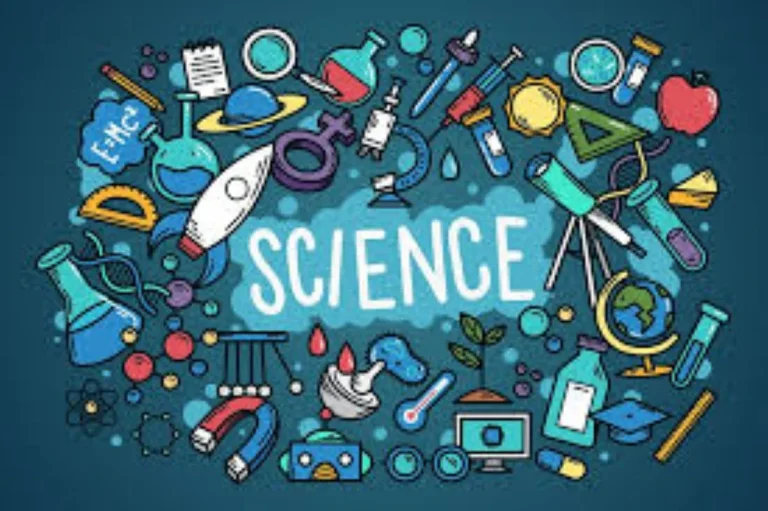
Difference Between Science And Non-Science
Science has long been regarded as the epitome of rational inquiry and knowledge about the natural world. But how exactly does it differ from non-scientific fields? If you’re short on time, here’s a quick answer: Science follows a rigorous methodology of empirical observation, experimentation, and falsifiable hypotheses to draw conclusions about how nature works. In…

Should I Study Computer Science? Analyzing The Pros And Cons
With career opportunities in high-paying fields like software engineering and data science, it’s understandable why many students consider studying computer science. But is it ultimately the right choice? This field offers immense potential but also has downsides to weigh. In this in-depth guide, we’ll assess the key benefits and drawbacks of studying computer science to…

- Return to Learning
Powered by Google Translate
What is the Capstone Project and how do I complete it?
The Capstone Project is your final course completion requirement and is where you present a practical plan for change: how can you apply what you’ve learned from the course to the real world? The Capstone Project is an opportunity to apply your new skills and knowledge to a practical solution.
Through this project, you will demonstrate your new skills by creating an environmental improvement plan for a digital solution in your own communities and/or contexts, e.g. a digital product ( a website, an app), digital service (online shopping, social media), digital process (virtual meetings, sharing files), or elaborating on ways you plan to raise awareness of green digital skills.
Throughout the course, you can share your ideas with other learners through online forums, whilst reaching out for support and feedback from your facilitator through Weekly Workshops, one-to-one check-ins, and direct messaging.
Join us by adding your own idea or project to thousands of other Capstone projects being created, shared, and executed around the world!
[email protected] | 2023
Capstone Projects for Nursing Programs

NurseJournal.org is committed to delivering content that is objective and actionable. To that end, we have built a network of industry professionals across higher education to review our content and ensure we are providing the most helpful information to our readers.
Drawing on their firsthand industry expertise, our Integrity Network members serve as an additional step in our editing process, helping us confirm our content is accurate and up to date. These contributors:
- Suggest changes to inaccurate or misleading information.
- Provide specific, corrective feedback.
- Identify critical information that writers may have missed.
Integrity Network members typically work full time in their industry profession and review content for NurseJournal.org as a side project. All Integrity Network members are paid members of the Red Ventures Education Integrity Network.
Explore our full list of Integrity Network members.
Are you ready to earn your online nursing degree?
Capstone courses function as a bridge between the end of school and the beginning of a career, allowing nursing students to put what they’ve learned into practice. As the name suggests, students complete capstones toward the end of their nursing training. Not every nursing program requires a capstone, but those that do generally culminate in a bachelor of science in nursing (BSN) or doctor of nursing practice (DNP) degree.
Each nursing program sets their own requirements. While capstone formats differ between programs, they typically consist of an evidence-based practice formal paper or presentation. Students might complete their capstone projects as team leaders, and BSN candidates may present their papers to a faculty panel. Projects could include case studies, program evaluations, and policy analyses.
The focus on evidence-based practice allows students to apply research and experiential evidence toward solving a healthcare problem. For example, candidates may develop intervention strategies that promote health, improve outcomes, enhance quality of life, and foster safe practices for patients.
Capstone goals center on the application of knowledge gained during nursing training programs, including topics related to leadership , management, research, theories, and evidence-based practice, along with the strategies needed to transition from students to baccalaureate-level nurses.
Choosing Your Nursing Capstone Topic
When selecting a capstone topic, students should evaluate their interests, strengths, and weaknesses, along with their chosen nursing specialty area. Luther College recommends that students with lower GPAs and weaker nursing skills consider a basic medical-surgical topic. Those with strong clinical skills and high GPAs might choose emergency or intensive care medicine, although some students might prefer outpatient topics, such as clinical services, long-term care, or public health. However, this is simply an example of one school’s approach, and readers should keep in mind that each school sets its own policies and recommendations.
Asking for guidance from faculty, supervisors, preceptors, and fellow students also helps narrow down capstone topics. Advisors can also provide assistance in choosing an appropriate capstone site, helping with questions of geographical location, facility size, patient population, and care delivery model.
Students develop and learn the skills needed to complete their capstones throughout their training. These include organization and time management, knowledge of evidence-based practice, writing, and critical thinking. They also learn to conduct literature searches, identify research designs, and evaluate evidence.
Completing Your Nursing Capstone
Capstone formats and completion times widely vary between programs. Students at Luther College and Purdue University Northwest complete their capstones in 4-5 weeks, while Ferris State University specifies a timeframe of 30 hours of online classes and 90 hours of applied project work. Case Western Reserve University’s capstone spans 10 weeks.
Regardless of the program, most students follow a PICO format for project proposal questions of inquiry: population, intervention, comparison or condition, and outcome.
Some universities allow capstone projects to be completed in teams, in which students develop and implement the project. Capstone components may include defining the project and the team leader’s role, selecting team members, and formulating the project plan.
In addition to the skills previously referenced, such as knowledge of evidence-based care, critical thinking, and effective writing, capstone courses hone leadership and management abilities These include mastering therapeutic communication, applying leadership and management concepts, and developing collaborative relationships and working on multidisciplinary teams.
Presenting Your Nursing Capstone
The capstone process culminates in a paper or presentation that measures students’ skills in communication, information dissemination, and application of evidence-based practice skills. Members of the public may attend.
Utilizing the poster format, students commonly use three panels to illustrate: (1) the background, problem, and purpose; (2) methodology; and (3) 2-3 key findings and implications. Students who present using PowerPoint on a laptop or other device should pay attention to time limits, planning for one slide per minute, and verify that equipment and internet connectivity are available.
Visuals like graphs, figures, and bullet points are more effective than large blocks of text . Students should practice presenting in front of others to ensure that they thoroughly know their content and can answer questions. Backing up a copy of a PowerPoint presentation and printing out copies or transparencies guards against last-minute glitches.
How is a Nursing Capstone Graded?
Capstone grading methods differ between programs, with some issuing letter grades and others using a pass/no pass system. Grades typically hinge on a percentage basis of the project’s written sections, the final proposal, and the presentation. Faculty evaluate how students execute the capstone course objectives, which may include the following:
Students’ presentation skill evaluation criteria include exhibiting thorough preparation and knowledge of the subject matter, clear and concise communication, adherence to any time limits, ability to answer questions and cite references, and persuasiveness.
What is the Difference Between a Nursing Capstone and a Thesis?
Students complete capstones individually or in groups, while thesis projects must be done alone. Capstone project time lengths span between four and 12 weeks, while graduate students work on their thesis projects throughout their 2- to 3-year programs. Graduate thesis courses generally take place over 1-2 semesters to keep students on track.
Finally, capstone topics evaluate current issues and theories; thesis students incorporate existing case studies and literature while exploring and arguing for their own original research. Some schools require students to publish their thesis papers in a healthcare journal.
Reviewed By:

Theresa Granger
Theresa Granger, Ph.D., MN, NP-C With over two decades of teaching and clinical practice as a family nurse practitioner, Dr. Granger is an expert in nursing education and clinical practice at all levels of education (associate, baccalaureate, and graduate). She has published and lectured extensively on nursing education and clinical practice-related content. Her expertise ranges from student advising and mentoring to curricular and content design (both on ground and online) to teaching and formal course delivery. Dr. Granger is one of the founding faculty members of the University of Southern California’s first ever fully online graduate family nurse practitioner program .
Whether you’re looking to get your pre-licensure degree or taking the next step in your career, the education you need could be more affordable than you think. Find the right nursing program for you.
You might be interested in

Best Online Nursing Programs and Degrees
Overwhelmed by the abundance of online nursing programs? This guide can help you navigate the possibilities and narrow down the options.

Nurse Practitioner Career Overview

Certified Nursing Assistant (CNA) Career Overview
- Global / English
- US / English
- EMEA / English
- India (SSIR) / English
- 日本 (DSRJ) / 日本語
What are you looking for?
Samsung austin semiconductor sponsored capstone project takes home first place, as a platinum sponsor of the texas a&m engineering showcase, samsung austin semiconductor sponsored five capstone projects. the 28 students worked on projects ranging from pump failure models to developing a methodology to monitor power supply health..
- #Workforce Development
If you want a quick solution, check out FAQ or Global Network first.
Business customer
- Individual customer
This field is required
- Asia - pacific
- Latin America
- Middle East
- North America
- South America
- Inquiry Category*
- Technical Support
- Corporate Functions
- Website Feedback
- Memory Solution Lab
- Inquiry Type*
- Product Category*
- Product Type*
* Find help about consumer storage product at samsung.com support.
Technical support
DRAM Component
Product Spec
Please, Check"I'm not a robot"
This site uses cookies to personalise your experience, analyse site traffic. By Clicking Accept or continuing to browse the site you are agreeing to our use of cookies. You can read our Privacy Policy and Cookie Policy for more information.
We use cookies to improve you experience on our website and to show you experience on our website and to show you relevant advertising, manage your settings for our cookies below.
These cookies are essential as they enable you to move around the website. This category cannot be disabled.
These cookies collect information about how you use our website, for example which pages you visit most often. All information these cookies collect is used to improve how the website works.
These cookies allow our website to remember choices you make (such as your user name, language or the region you are in) and tailor the website to provide enhanced features and content for you.
These cookies gather information about your browser habits. They remember that you've visited our website and share this information with other organizations such as advertisers.
Cookies are small files that store information on your computer, TV, mobile phone, or other device. They enable the entity that put the cookie on your device to recognize you across different websites, services, devices, and/or browsing sessions.
Texas Tech Now
Engineering capstone project yields useful tool.
May 17, 2024

A piece of research equipment made by students will be used in the Edward E. Whitacre Jr. College of Engineering.
What started as a capstone project handed to a group of students in Texas Tech University 's Edward E. Whitacre Jr. College of Engineering has yielded a useful tool for future research.
Given the opportunity to select a project, the undergraduate students in the Department of Mechanical Engineering leaned into helping current and future graduate students by creating a tool that could be used in rocket research.
The equipment built by the students is called a thrust stand, and if you're not exactly sure what that is, you're not alone.
“Basically, a thrust stand is a mounted rocket motor,” explained Joseph Pantoya, one of the mechanical engineering students involved in the project. “It collects thrust and pressure data for a given rocket fuel.
“What we can do is get fuels that the combustion lab makes, put them in our rocket motor and test them out in a controlled environment.”
The capstone course brought together a team of six students from diverse backgrounds to complete the final steps in their mechanical engineering degrees with their project supported by grants from the U.S. Department of Energy (DOE) and the U.S. Department of Defense (DOD).
Grants from sources like DOE and DOD give professors the resources needed to supply students with a hands-on learning experience while also creating something of value for the wider world.
In this case, the thrust stand will be used by both graduate and undergraduate students in the Combustion Lab , where testing of accelerants used in various types of rockets takes place daily. The capstone project will help researchers test solid fuel combustion and better understand how those fuels can be designed to advance hypersonic combustion for propulsion applications.
“Being able to help students in the lab publish research papers one day with something we designed is really cool,” said Juan Aguirre, another of the students involved with the thrust stand project.
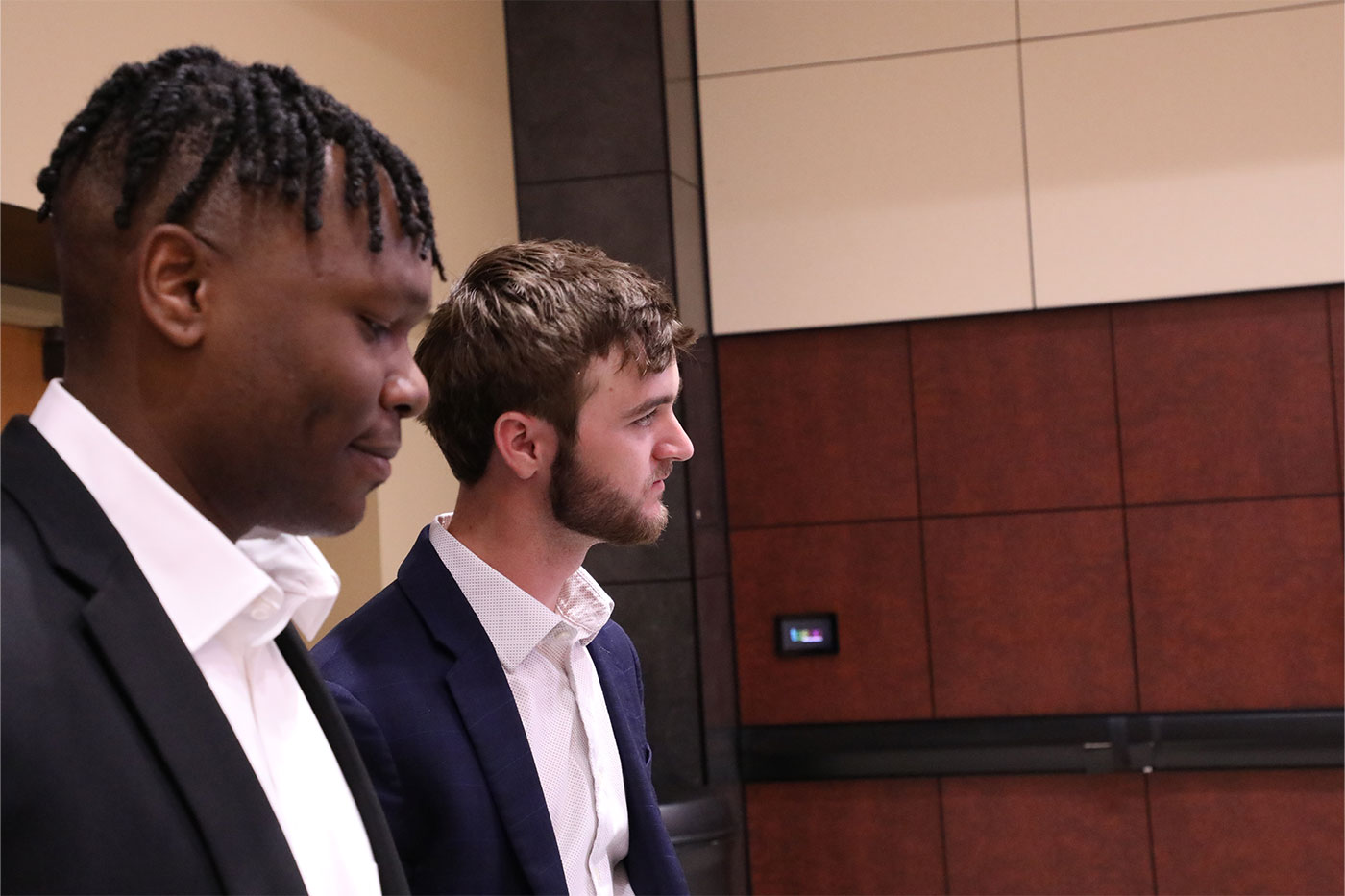
The project required working with graduate students in the lab to understand and address their needs in the design phase. Meeting the needs of those students was a critical piece of the puzzle, but it wasn't the only piece.
Moving from the theoretical aspects of design into the actual production phase, managing a budget and producing a useful final product were all hurdles the thrust stand team had to conquer.
“We had a lot of challenges,” team member Ajibek Karatalov said. “Most of the challenges were logistical. For example, one of the main parts was shipped from Japan, and it never made it. I don't know why. So, these kinds of challenges were sort of boundaries, but I'm glad that we overcame them as a team.”
Luckily for the students, there are plenty of resources and mentors to lean on. Mechanical engineering's machine shop, for instance, provided the expertise the students needed to work through many of the technical issues along with the sage advice that comes from working with professionals.
“I think having the shop instructors, Roy Mullins and David Meyers , they kind of gave us a new perspective on the issues we were facing,” said Jeffery (Mitch) McHugh, another team member. “They had more of a rounded perspective because they've worked in the field. That really helped us and gave us a perspective of what people that we may be working with in the future will have to say.”
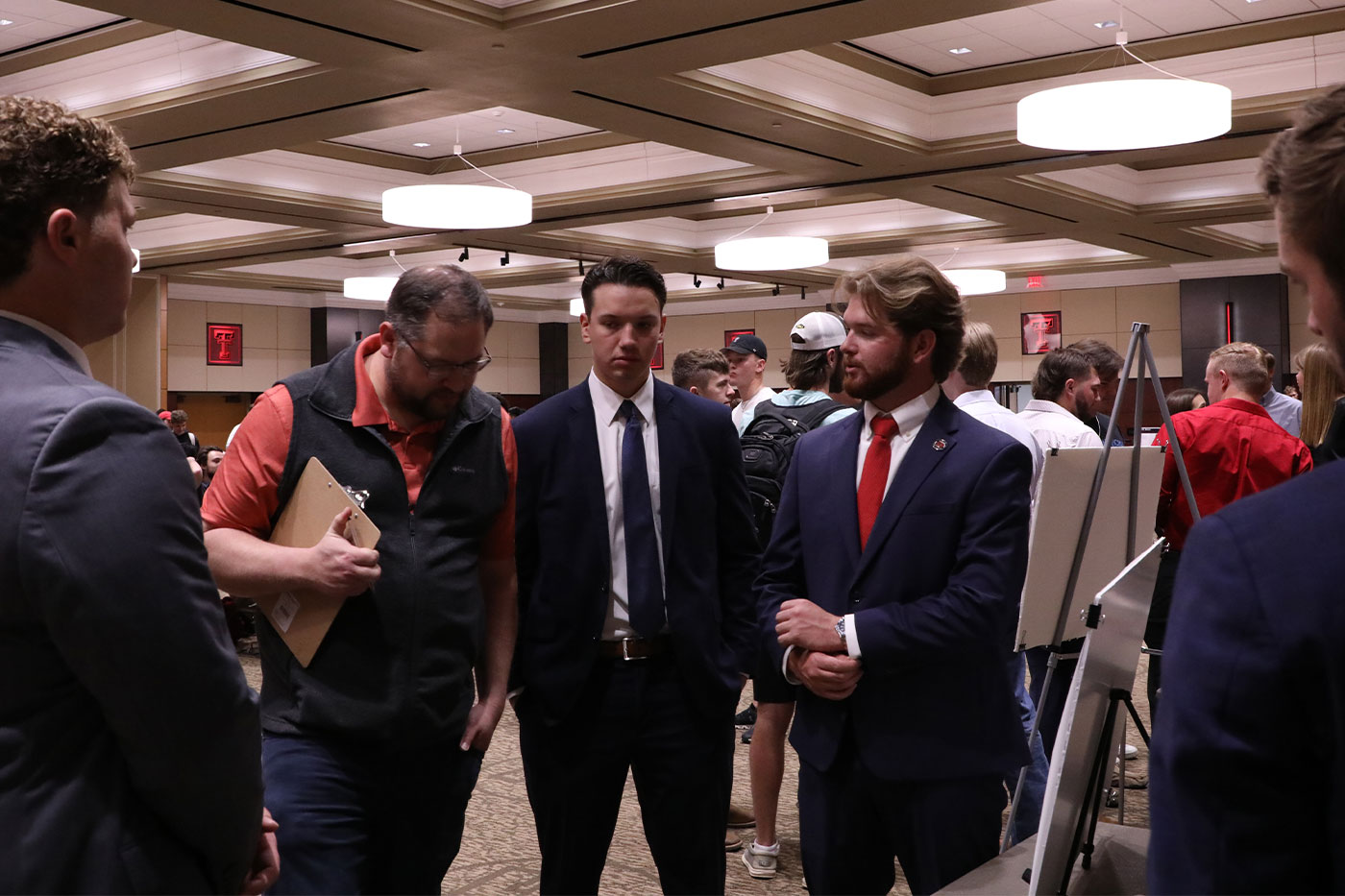
The team's design was on display at the Mechanical Engineering Expo, an event held on Texas Tech's campus where, along with other teams from the department, the work of the last year is shown off to the campus community.
Mullins and the staff at the machine shop work with a wide range of students daily, helping with things like welding and machining parts that wouldn't normally be done by engineers in the field, and he was impressed with the thrust stand team's competency.
“They've been a pretty self-sufficient group, actually,” Mullins said. “We've had to answer the usual technical questions and assist them in some machining, but for the most part, with the end design they've done really well on their own.
“It was a very specific subject. It was a research project tied to research we do in the department, so that was kind of unique in and of itself. But what really struck us about this project was it was for a research project that ties immediately to a critical problem.”
You may also like
Texas tech's psychology clinic has new home, bigger mission, texas tech professor receives $2 million grant for produced water research.
- Liberty Online
- Residential
- Request More Information
- (434) 582-2000
- Academic Calendar
- Bachelor’s Degrees
- Master’s Degrees
- Postgraduate Degrees
- Doctoral Degrees
- Associate Degrees
- Certificate Programs
- Degree Minors
- Registrar’s Office
- Degree Completion Plans (DCPs)
- Course Catalog
- Policy Directory
- Academic Support (CASAS)
- LU Bookstore
- Research at Liberty
- Eagle Scholars Program
- Honors Program
- Quiz Bowl Team
- Debate Team
- Student Travel
- Liberty University Online Academy (K-12)
- Tuition & Costs
- Net Price Calculator
- Student Financial Services
- Scholarships
- Undergraduate
- International
- Apply for LU Online
- Online Admissions
- Online Tuition & Fees
- Military Students
- School of Law
- Osteopathic Medicine
- Convocation
- Campus Community
- LU Serve Now
- Liberty Worship Collective
- Office of Spiritual Development
- Online Engagement
- LU Shepherd
- Doctrinal Statement
- Mission Statement
- Residence Life
- Student Government
- Student Clubs
- Conduct Code & Appeals
- Health & Wellness
- Student Affairs Offices
- Campus Recreation
- LaHaye Rec & Fit
- Intramural Sports
- Hydaway Outdoor Center
- Snowflex Centre
- Student Activities
- Club Sports
- LaHaye Ice Center
- ID & Campus Services
- Dining Services
- Parents & Families
- Commuter Students
- International Students
- Graduate Students
- Disability Support
- Equity & Inclusion
- NCAA Sports
- Flames Club
- Varsity Club
- Williams Stadium
- Vines Center
- Liberty Baseball Stadium
- Kamphuis Field
- Ticket Information
- Flames Merchandise
- LU Quick Facts
- News & Events
- Virtual Tour
- History of Liberty
- Contact Liberty
- Visit Liberty
- Give to Liberty
Engineering students collaborate with industries on capstone projects
Search news archives, filter news articles.
Additional Navigation
May 8, 2024 : By Ted Allen - Office of Communications & Public Engagement
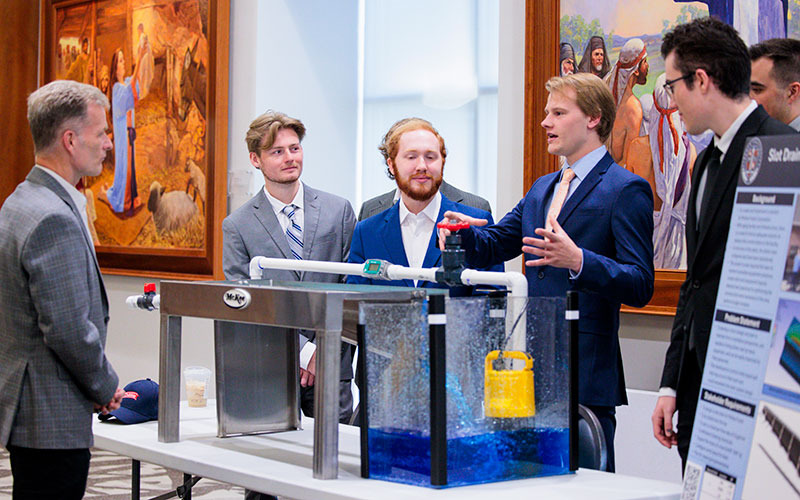
Capstone, also known as senior design, is the culminating academic experience for Liberty University School of Engineering (LUSE) students and a significant résumé-enriching achievement as they prepare to transition to professional careers.
“Each student works on a team of four to six to design a new product or process or make significant design improvement on existing systems,” said Dr. Howie Fang, a professor and chair of the mechanical engineering department and director of LUSE’s capstone program. “It’s a creative activity, and students do that for their client, who works with the student team over the period of two semesters.”
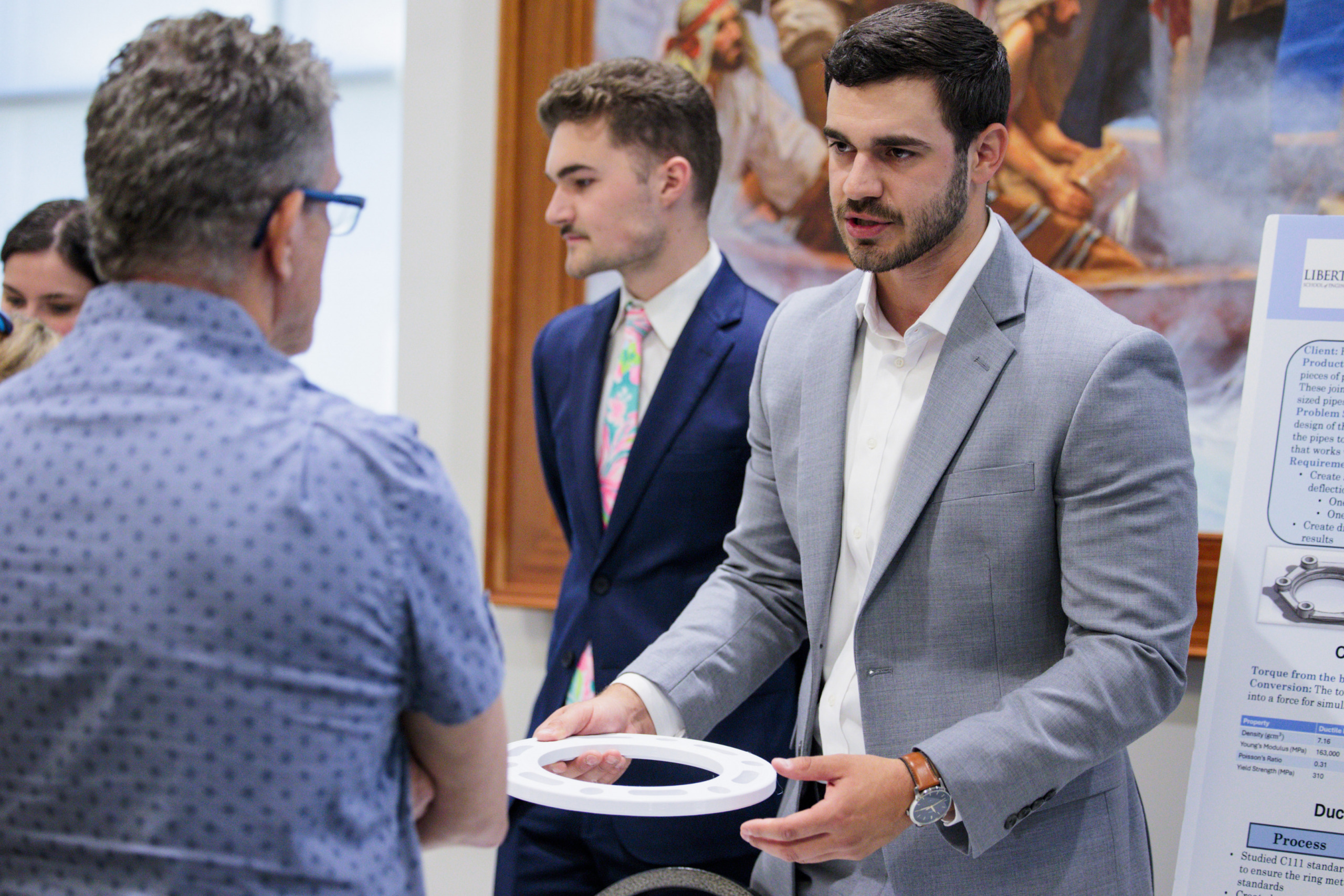
That creativity and collaboration was on display during Thursday’s Engineering Capstone Expo in the Montview Alumni Ballroom. For this academic year, LUSE offered 22 capstone projects to 97 engineering students with 18 projects from industry partners. Area businesses included Automated Conveyer Systems Inc., Centra, Delta Star, Framatome, Harco Fittings, Lawrence Companies, and Master Engineers & Designers. Students also worked with multi-industry companies such as Textron, and government agencies like NAVAIR, who have provided funding for and benefited from students’ innovative capstone projects. (See the full list of industry sponsors below.)
“It is very important for our students to learn real-world engineering problems and how to find solutions to those problems before they go out and get into industry as engineers,” Fang said. “Then, they are prepared and comfortable applying what they have learned in the classroom to real-life engineering challenges in their new jobs.”
Capstone teams involved students from all five engineering programs: mechanical, electrical, computer, industrial & systems, and civil engineering.
“Dr. Howie Fang is a world-leader in design optimization methodologies and has taught that in the context of the Creationeering process to the senior students while integrating it with real-world engineering problems,” School of Engineering Dean Mark Horstemeyer said, with Creationeering referring to his coined term for the interface between business and engineering and the creative inspiration from God in students’ research and design. “I am so proud to have Howie Fang in the LUSE as his leadership has raised the standard for the school.”
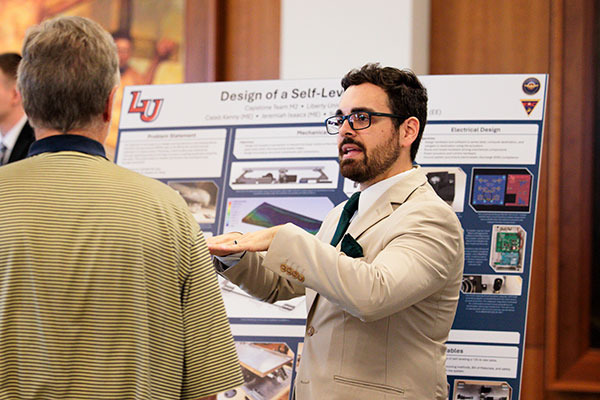
Such was the case for Tanner Randall, who will start this month at Framatome in its thermal hydraulics and component testing center after leading a team of six mechanical engineering students who worked under the supervision of Framatome mechanical engineer and software developer Greg Troyer to analyze the natural frequencies of nuclear reactor vessel internals (RVI), which facilitate fission in extreme environments. Christopher Pace, an electrical engineering student who worked on another Framatome-sponsored project, has also been hired by the company, which has its North American headquarters in Lynchburg, Va.
Katherine Rioux and fellow mechanical engineering students Fady Fayek, Caleb Schaible, and Logan Drawbaugh worked with Dr. Andy McIntosh from Leeds University in England to develop a Biomimic Novel Spray System, using the bombardier beetle as its model for extinguishing fires. She has landed a job working on E2D Hawkeye Airborne Command and Control Aircraft at NAVAIR in Patuxent, Md.
“It’s been a steep learning curve, but the cool thing about being tossed into the deep end is you either sink or swim, and I didn’t want to sink, so I learned,” said Rioux, who had internships with NAVAIR over the past two summers.
At last spring’s Expo, Josh Ingram and his team won the Capstone Legacy Award for their best product design for NAVAIR, a small tool that can be used to repair the engine of the V-22 Osprey tiltrotor aircraft. Ingram was hired by BWXT last May while Zach Deluth, another member of this team, was hired by NAVAIR.
“The team worked with NAVAIR really well, and the product the students delivered to them is ready to be made for them to use to maintain these aircraft, so they were really happy,” Fang said.
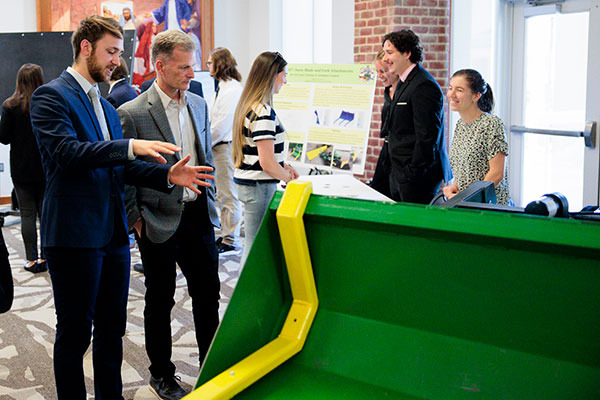
Due to the quality of work produced by the engineering students on that capstone project, NAVAIR’s Cherry Point, N.C., location sponsored two capstone projects for Liberty’s engineering students this year.
Several of the seniors said the capstone projects stretched them more than any other class they had taken toward their degree, challenging them to put what they have learned in the classroom into practical application.
“It’s hands-on, working with a real customer, solving real problems, and it really made them think through, identifying what the problem is, coming up with solutions to that problem,” School of Engineering Lab Manager Marc Jantomaso said. “They built really good relationships with the clients.”
In recent years, as the School of Engineering has grown — both in number of students and faculty and in reputation in the Lynchburg, Va., area and around the nation and the world — more and more connections have been made between graduating seniors and area engineering companies.
“Through the capstone program, we have built up some very good relationships with industry that will tremendously benefit our engineering students, as well as the industry, providing the students with opportunities to refine their learning and open doors for employers to hire highly skilled graduates,” Fang said. “It’s a win-win situation. We can have more impact for students if we bring real-world applications, real-world projects from industry and let students work with industry people directly in these projects.”
This year, the projects received more than four times the total amount of funding as last year, allowing the seniors to develop more elaborate projects with greater functionality.
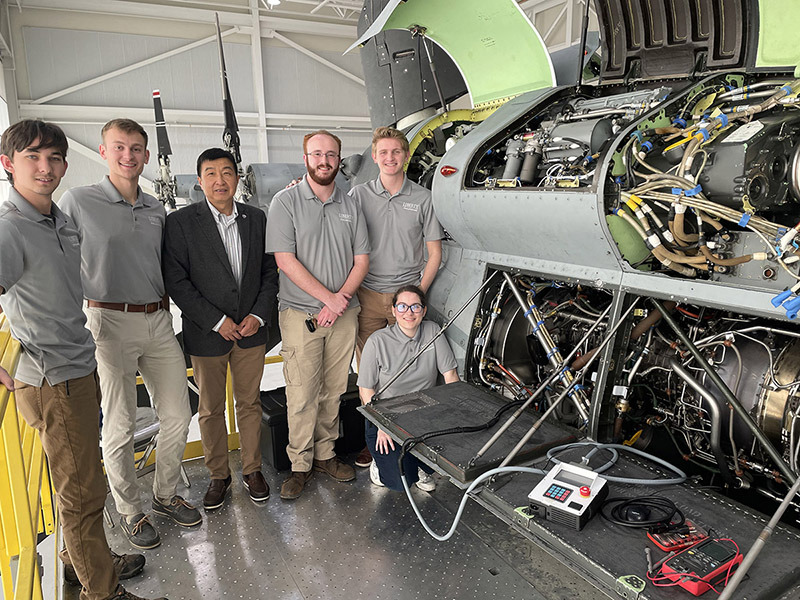
“They have more financial resources now, so they can do more,” Fang said. “When you go out to industry, your project can run anywhere from hundreds to thousands of dollars. That is the scale type of work from industry, and that is very beneficial to students if you can have a project with that complexity. So, from that perspective, we try to attract as many industry projects as possible.”
With genius inspired by God, and plenty of direction from faculty advisors and the clients they are doing their capstone projects for, the student teams “make miracles happen,” said Liberty President Dondi Costin, who attended the Expo.
“I was blown away at every single station, and I couldn’t believe it,” he said. “This is a true testament of your education … (and) exactly what Liberty University is all about. It’s taking young men and women who have natural talent and who have been raised with character and who are brought here by God, who have an individual ability and skill and passion and motivation and coming together as a team and using that skill in concert with the skills of others who are just as intelligent and passionate and gifted.”
2023-24 Engineering Capstone Industry Sponsors
Automated Conveyer Systems (ACS) Inc.
Centra Health
Corvid Technologies LLC
Delta Star, Inc.
Energy & Automation, Inc.
FarmBot Inc.
Harco Fittings
Kapstone Projects LLC
Lawrence Companies
Master Engineers & Designers
McKee Foods Corporation
U.S. Navy’s Fleet Readiness Center East (NAVAIR)
Textron Specialized Vehicles
Related Posts

Liberty graduate completes bachelor’s degree at age 15

81-year-old veteran earns master’s degree in aviation from Liberty
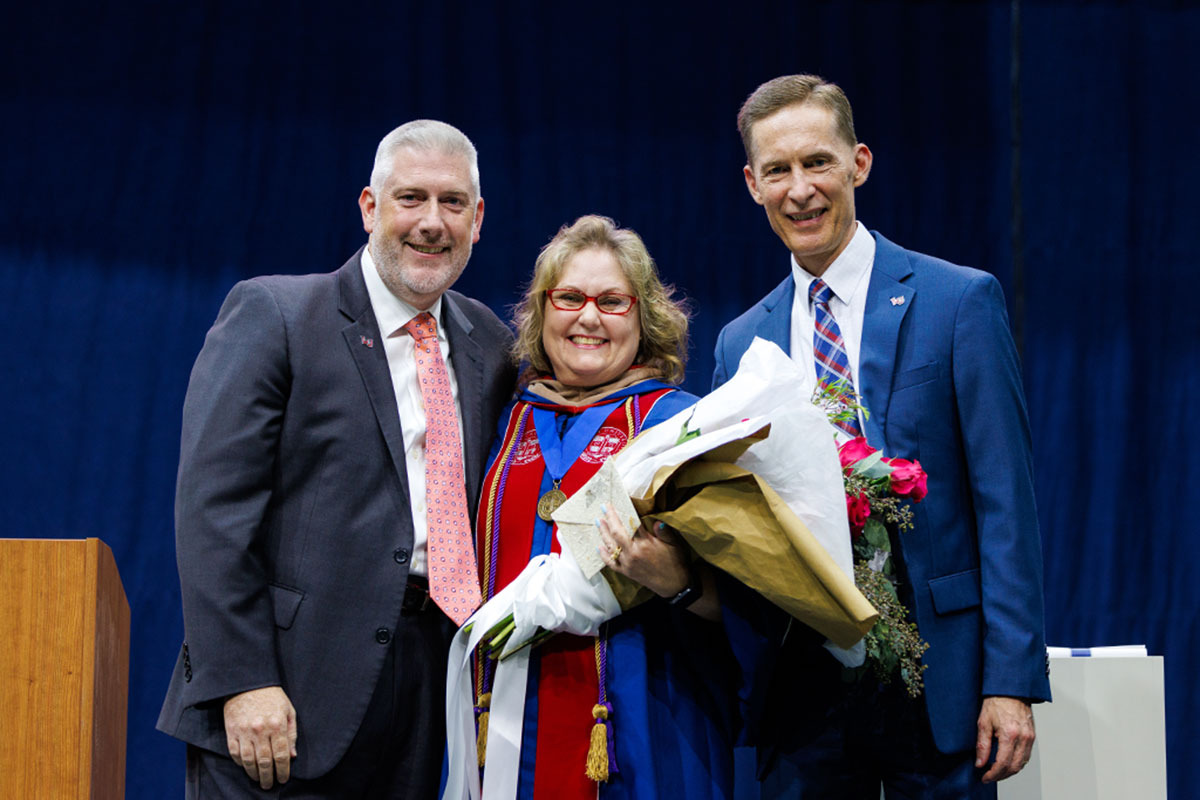
Dr. Beth Koss receives CUSA’s 2024 Faculty Achievement Award
School of Medicine Department of Family Medicine
Department of family medicine, scholarly projects.
As part of a fully integrated four-year residency, our residents complete an individual, longitudinal capstone project which requires sustained effort over the four years of residency. These projects provide residents with the opportunity to integrate and demonstrate their knowledge of a subject that interests them.
Upon completion, residents will have produced one of the following learning outcomes:
- Development of a postgraduate medical education curriculum that is testable and can be implemented by our residency or in other educational settings.
- A quality improvement intervention that can be reported in a publication that reflects the Standards for Quality Improvement Reporting Excellence (SQUIRE) publication guidelines.
- A clinical or community-based research project that results in a peer-reviewed, publication-ready article.
Developing one of these three learning outcomes provides our residents another avenue for professional development and a means to contribute to the knowledge base of the medical profession.
Examples of past capstone projects
- “Feasibility of a Telemedicine Model for Inpatient Palliative Care Consults”
- “Transgender Health Curriculum”
- “The Effects of Psychosocial Adversity, Adult Attachment and Resilience on Health”
- “Reproductive Health Services at School-Based Health Centers in Oregon”
- “Predictors and Barriers of Transfers of HIV Care Between Rural Health Centers in Kenya”
- “A Pilot Study to Investigate the Feasibility and Efficacy of Primary Care Physician- Led Shared Medical Appointments for the Treatment of Co-Morbid Major Depressive Disorder and Diabetes"
Capstone topics and recorded presentations
Class of 2023.
May 2023 Presentations: Capstone Project Presentations Group One ( access code: GuxtSg2d)
Michelle Scheurich: Obstetric and Newborn Services in Rural and Frontier Oregon - A Needs Assessment
Omar Fares: Implementing a Point-of-Care Ultrasound Curriculum for Family Medicine Residency Faculty
Britt McAdams: Training with Family - A Needs Assessment of Current and Former Parenting Residents in OHSU's Family Medicine Residency
June 2023 Presentations: Capstone Project Presentations Group Two (access code: fNB86Qwp)
Ryan Nesbit Deane: BATHE for Resident Wellness - Findings from Inpatient Rounds
Eliza Slater: Continuity of Community Care in Cuba - Lessons for Rural America
Alexa Rawlins: Battling the Inner Critic - Practices in Self Compassion and Reflection for OHSU Family Medicine Residents
Andrew Wang: Scope - Investigation of Family Medicine-Performed Colonoscopies in Oregon
Sara Shimanek: Assessing Utilization of the Paracervical Block in Family Medicine Faculty Clinical Practice
Katie Pavlat: Medicine Inpatient Service Patient Presentations Pre and During Covid-19 Pandemic
June 2023 Presentations: Capstone Project Presentations Group Three (access code: pMi7P2hF)
Sienna Nelson: Increasing Fetal Monitoring Access for High-Risk Pregnancies in a Rural County
Brooke Bachelor: OHSU Integrative Health Collaborative (OIHC): Exploring Virtual Platforms as a Tool for Integrative Health Collaboration
Emily Dollar: Food as Medicine - Evaluating a Vegetable Prescription Program in Oregon
Hilary Titus: Senioring ( https://youtu.be/AriWxcIWd84 ) - click on the link to view.
Class of 2022
May 2022 Presentations: Capstone Project Presentations Group One (access code: 3rRKXrmY)
Nikki Cairns: Addressing Gender Bias in Remediation and Feedback
Robin Vest: Human Papillomavirus Vaccination for Postpartum Patients: A Quality Improvement Initiative
Ishak Elkhal: A Foray into Biostatistical Modeling in the World of COVID
Justin Lee: Implementation and Assessment of Anti-Racist Structural Competency Training for First Year Medical Students
May 2022 Presentations: Capstone Project Presentations Group Two (access code: Yf9vQa8F)
Patty Tran: Community Health Needs Assessments of the Asian American Population in the Portland Metropolitan Area
Nate Andrews: Integration of Lifestyle Medicine into OHSU Family Medicine Residency Curriculum
Laurence Moore: CPCC Reverse Integrated Behavioral Health Clinic Impact Study
Annie Buckmaster: @ohsufamilymedres: Social Media as a Tool for Applicant Recruitment
June 2022 Presentations: Capstone Project Presentations Group Three (access code: jF2eTpSP)
Elizabeth Corwin: An Educational Presentation for OHSU Family Medicine Providers with Aim to Improve Screening for Tuberculosis in Prenatal Patients
Arisa Takeuchi: Improving SIC Conversation in FM Residency
Mel Ruberg: The F.R.E.E.dom Experiment: Family Residents Exploring Evidence
Class of 2021
May 2021 Presentations: Capstone Project Presentations Group One ( access code: bUTi6RGP )
Josh Cohen: Mixed Methods Analysis of Outcomes of Graduates of OHSU's 4 year FM Residency
Colleen Cooper: The EMBRACE Curriculum: Creating a Medical Student Elective on Neonatal Opioid Withdrawal
John Mitchell: Physical Activity Promotion in Primary Care: Exercise as a Vital Sign
May 2021 Presentations: Capstone Project Presentations Group Two ( access code: Wyv53i3m )
Jenan Hilal: Needs Assessment for Reproductive Health Access in Columbia County
Di Deng: POCUS Curriculum Development in the Time of COVID
Megan Quinlan: Improving Inpatient Didactic Teaching for Residents on a Family Medicine Inpatient Service
Dan Slowey: Medical Legal Partnerships: Challenges, Solutions, and Reflections
June 2021 Presentations: Capstone Project Presentations Group Three ( access code: Pj5unC6M )
Katie Putnam: Landscape of Pregnancy Care in the Safety Net Setting
Ben Colburn: "The Interstitium": A Novel Medium for Meaning - Making in Healthcare
Roheet Kakaday: Facilitating Gender Affirming Hormone Therapy via an EHR-based SmartSet
Alex Domingo: Virtual Residency Interviews: Equity, Effectiveness, and Carbon Footprint
Class of 2020
May 2020 Presentations: Capstone Project Presentations - Group One
Stuart Zeltzer: Improving Chronic Condition Coding and Documentation among Family Medicine Residents through a Web-based Interacting Learning Module Ryan Manns: A Food Insecurity Project at the Benson School Based Health Center Amanda Aninwene: Evaluation of Health Equity & Social Justice Book Club/Discussion Group in Family Medicine at OHSU Mustafa Mahmood: Mental Health in Portland's Muslim Population
May 2020 Presentations: Capstone Project Presentations - Group Two
Jean Yau: Knowing & Growing: Healthy Bodies, Healthy Hearts, Healthy Lives Melissa Logan: Predicting 30 Day Hospital Readmissions to the Family Medicine Inpatient Service Cait Williamson: Postpartum Depression Screening at Gabriel Park: Practices and Barriers Dominic Caruso: Planning School Health Services in the Scappoose School District: Performing a Community Needs Assessment Maria Palazeti: Maintaining Values in Medicine Brit Nilsen: Equity and Inclusion Curriculum in Family Medicine Residency Kristen Otto: Family Medicine in Botswana: Adapting an International Rotation for OHSU FM Residents Claire Montaigne: Patient Perspectives of Project Nurture - A Qualitative Analysis
Class of 2019
May, 2019 presentations: Watch the full video here .
Mustafa Alavi: Who Really Matches into Primary Care & Why Family Medicine? Jenna Walters: Establishing a Hospital-based Medical Legal Partnership Kris Azevedo: Training OHSU Family Medicine Residents in Medication Assisted Treatment for Opioid Use Disorder Ben Hersh: Developing an Objective Structured Clinical Exam (OSCE) to Improve Transgender Health Care Michael Tudeen: Program Evaluation of Oregon Medicaid's Planned Out-of-Hospital Births Requiring Transfer to the Hospital Gabe Plourde: Opiate Use Disorder Capstone - A Multifaceted Approach Lisa Kipersztok: Family-Centered Neonatal Opioid Withdrawal Syndrome (NOWS) Care: A Multi-disciplinary Improvement Initiative at OHSU
June, 2019 presentations: Watch the full video here .
Rachel Sircar: Depression and ACE Screening in Pregnancy Hans Han: Development of a Resident Curriculum in Japan Maggie Wells: Hill Family Handbook for Patient and Physician Wellness Kelly Shaffer: Adventure Therapy for the Treatment of Addiction Cait Goss: Acquisition of Sexual and Reproductive Health Education Jessica Cody: The Impact of Stress on Work Productivity among Thai Hospital Employees Sarah Skog: Assessment of Diabetes Distress in a Patient Centered Primary Care Home

COMMENTS
2. Select your best work. 3. Organize your work. 4. Reflect on your work. 5. Present your work. Portfolio and capstone projects are often the final and most challenging assignments in higher ...
This blog post will provide you with a comprehensive guide on how to plan, start, and finish your capstone project. From understanding the goals and objectives of your project to finding the right ...
This is what the Projects menu looks like as you start to add your projects on LinkedIn. Type in the details for the project. You'll need to include: Project name. Start date and end date (it's OK to just have years). Any other colleagues who worked on the project with you.
The Projects section of your LinkedIn profile is the perfect place to spotlight your involvement in company-driven initiatives. Long-range, high-yield projects that deserve a bigger spotlight than a simple bullet in your Experience section belong in the Projects section. Choose projects that make you proud and show that you helped move the ...
Capstone project | 2 followers on LinkedIn. ... ## 10 Arduino Projects to Streamline Your Small Office: From Efficiency to Fun!
1. It prepares you for the working world. The capstone project is designed to consolidate final-year students' learning with valuable hands-on experience to help develop them into well-prepared and well-rounded graduates. Students work together in small groups to come up with innovative solutions for real-life problems, all while gaining ...
Capstone Projects. The Capstone is a culminating academic project experience that is completed within the confines of a semester-length course. Several Master of Liberal Arts (ALM) fields either require a capstone or offer the option to pursue one. In addition to the information below, review Guide to the ALM Capstone Project website.
A capstone project is a culminating assignment that allows students to demonstrate the skills and knowledge they've acquired throughout their degree program. For data science students, it's a chance to tackle a substantial real-world data problem. ... Depending on the research goals, other platforms such as LinkedIn, YouTube, and TikTok can ...
The Capstone Project is an opportunity to apply your new skills and knowledge to a practical solution. Through this project, you will demonstrate your new skills by creating an environmental improvement plan for a digital solution in your own communities and/or contexts, e.g. a digital product ( a website, an app), digital service (online ...
Completing Your Nursing Capstone. Capstone formats and completion times widely vary between programs. Students at Luther College and Purdue University Northwest complete their capstones in 4-5 weeks, while Ferris State University specifies a timeframe of 30 hours of online classes and 90 hours of applied project work.
Open to work, Visakhapatnam,Andhra Pradesh · With passion for data analysis and with technical skills, excited to contribute to data-driven organisation and continue learning and growing in the field of data science. Have a good skill in extracting valuable insights from data, enabling informed decision-making and propelling organisational success. · Experience: Capstone Project · Education ...
As a Platinum sponsor of the Texas A&M Engineering Showcase, Samsung Austin Semiconductor sponsored five capstone projects. The 28 students worked on projects ranging from pump failure models to developing a methodology to monitor power supply health. ... Linkedin: ads.linkedin.com, linkedin.com, px.ads.linkedin.com, www.linkedin.com: Close ...
What started as a capstone project handed to a group of students in Texas Tech University's Edward E. Whitacre Jr. College of Engineering has yielded a useful tool for future research.. Given the opportunity to select a project, the undergraduate students in the Department of Mechanical Engineering leaned into helping current and future graduate students by creating a tool that could be used ...
GHC'23|Applied Data Science @UChicago, Computer Science & Data Science @UW-Madison · My name is Boya Zeng. Currently a graduate student in the University of Chicago's M.S. in ...
Due to the quality of work produced by the engineering students on that capstone project, NAVAIR's Cherry Point, N.C., location sponsored two capstone projects for Liberty's engineering ...
As part of a fully integrated four-year residency, our residents complete an individual, longitudinal capstone project which requires sustained effort over the four years of residency. These projects provide residents with the opportunity to integrate and demonstrate their knowledge of a subject that interests them.
🚀 Capstone Project Update: Off to a Strong Start! As we wrap up an exhilarating first week of our Capstone project, I'm eager to share the incredible…
Project Manager jobs ... Capstone | 18,916 followers on LinkedIn. A global strategy firm helping corporations & investors navigate policy & regulatory landscapes. | Capstone is a global strategy ...
Capstone Project | 30 followers on LinkedIn. ... CAPSTONE PROJECT SERVICES PLLC (CAPSTONE PROJECT SERVICES, PLC) Architecture and Planning
Skip to main content LinkedIn. Articles ... Jobs Join now Sign in Capstone Project Services, LLC's Post [Video] Capstone Project Services, LLC 30 followers